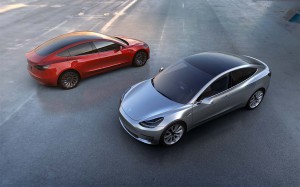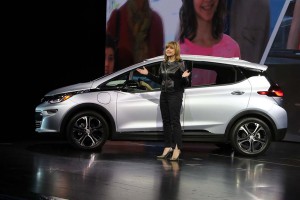
Tesla buyers may no longer qualify for federal tax credits by the time the Model 3 reaches showrooms.
When the Tesla Model 3 finally goes into production, in late 2017 or early 2018, buyers might be in for an unpleasantly costly surprise – one that fall particularly hard on customers who were hoping to get that new battery sedan at a relatively affordable price.
American motorists buying the carmaker’s two current products, the Models S and X, stand to receive federal tax credits of $7,500. Industry analysts say that incentive has helped draw many buyers into the battery-car market. But under federal guidelines, those givebacks might be gone before the first Tesla Model 3 hits the road.
When Congress passed the measure aimed at spurring demand for battery-based vehicles – including both plug-in hybrids and pure battery-electric vehicles, or PHEVs and BEVs – lawmakers set a cap on those incentives, limiting them to just the first 200,000 vehicles sold by a particular automaker.
(For a closer look at the Tesla Model 3, Click Here.)
Tesla sold about 50,000 vehicles in 2015, bringing total volume since it was founded 13 years ago to 80,000 battery-electric vehicles. Despite the unexpectedly slow ramp-up of production of the new Model X during the first quarter of 2016, Tesla says it remains “on target” for a goal of building somewhere between 80,000 and 90,000 vehicles for the full year.
That would bring its total volume to at least 160,000. And, with plans to increase production even more in 2017, that would likely mean all of Tesla’s remaining tax credits will run out by mid-year, at the latest, leaving an unpleasant surprise for Model 3 buyers.
Tesla buyers won’t go cold turkey, but will see the tax credits initially cut in half, then halved again over a period of six months. So, at most, only a small number of those buying the smaller sedan will get the federal handouts.
It is possible that Congress might have second thoughts, especially at a time when the battery-car business is struggling. Sales of all plug-based models actually dipped last year, after peaking around 100,000 in 2014. The Obama Administration has tried to get the tax credits extended, but that request has fallen on deaf ears in a Republican Congress showing little interest in alternative energy.
(Early orders growing fast, but will the Tesla Model 3 be a hit or a hype? Click Here for more.)
Tesla isn’t the only maker that could soon run out of federal EV credits. Until recently, the Nissan Leaf was the nation’s best-selling battery-car, though sales slipped in 2015 to just 17,269, down from around 30,200 the year before. On sale since late 2009, total Leaf volume has also broken through the 100,000 barrier. Nissan hopes to reinvigorate demand with a bump in range, to 107-miles, this year.
General Motors isn’t all that far behind with the Chevrolet Volt plug-in hybrid, which generated 15,393 sales last year and 18,805 in 2014. Chevy brought out an all-new version of the Volt this year, boosting battery range while lowering the price tag. Meanwhile, it’s planning to add the new Bolt battery-electric model later this year. But even if that new model hits its target, Chevy buyers should be able to get a couple more years of tax credits before they run out.
That could provide Chevy an initial advantage over the Tesla Model 3, though the Silicon Valley automaker doesn’t seem to be particularly worried. It has already logged close to 300,000 advance reservations for the smaller model in just the week since it was first unveiled. It remains to be seen if those pre-orders will actually translate into sales – and how soon Tesla would be able to meet demand. It has a history of being late with new models and slower than promised in boosting production.
(“Hubris” caused slow launch of Model X, concedes Tesla. Click Here for the story.)
Even after the federal battery-car credits run out for individual automakers, buyers may still qualify for help. A number of states have passed their own incentives. In California, for example, that means a maximum $2,500 for a BEV and $1,500 for a PHEV. Louisiana offers tax credits of 36% of the cost premium over a comparable, gas-powered vehicle. Washington State waives various taxes and fees.
Adding to the financial incentives, a number of states also offer coveted HOV stickers that allow qualifying vehicles access to faster-moving commuter lanes.



The cap of 200,000 units applies to vehicles sold in the United States, since its provided by the US government to spur sales of electric vehicles in the US. Since Tesla has significant sales in Europe and other countries including China, it would not be accurate to base your story of incentives running out for US buyers on Tesla’s production numbers. While specific sales information by country is hard to come by for Tesla, you could at least include a Reader Note in your story to let them know that only a portion of Tesla’s sales count toward the cap.
Nick, point taken. Reality is that sales abroad account for only a fraction of their sales so far. China has, even by Musk’s admission, been a virtual no-go so far, and Europe hasn’t done much better. Based on the breakout so far and even providing a slight improvement in 2016 and ’17, the odds suggest the US credits will run out by the time the Model 3 debuts or soon afterwards, at the latest.
Paul E.